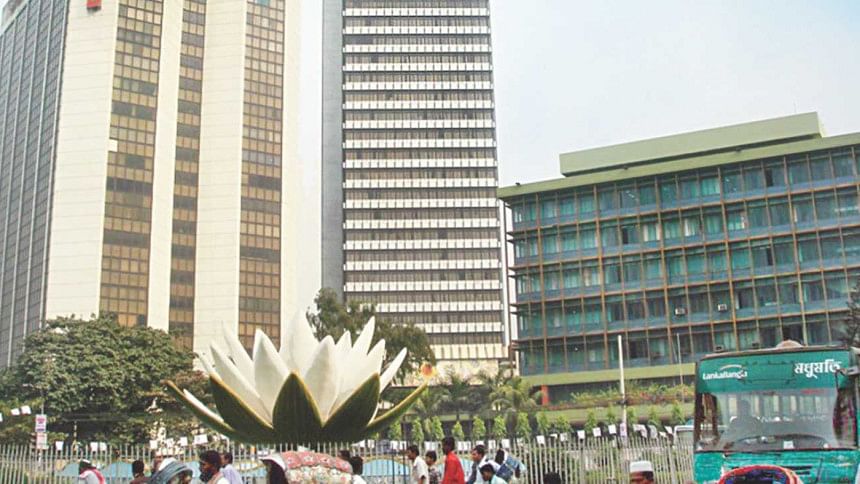Banking sector: Regulations, compliance and good governance

The global financial and economic crisis started in 2007 as an aftermath of the housing sector bubble coupled with aggressive lending practices in the US sub-prime mortgage market and lax regulation of the financial sector. The financial crisis, like a contagious disease, spread to the real sector of the US economy and affected both financial and real sectors of the world, making the crisis a global and very serious challenge for economic activities.
The root cause of global recession can be traced back to the mismanagement of banks and financial institutions. Despite all the measures taken by different countries, with the US taking the lead, full recovery has not yet been forthcoming. The year 2015 will be a challenging one. Small economies like Bangladesh are by no means invulnerable to fallouts from global downturns or negative spill over of policies of large economies and therefore have a strong stake in global stability and economic growth. In forums such as the G-20, countries like Bangladesh need to argue forcefully for the same priority in stability as recovery, as well as for stability action agenda going beyond addressing symptoms (i.e. lapses in risk management, inadequacies of regulation and supervision) to addressing underlying causes (i.e. lax policies, non-compliance of prudential and management norms, poor financial reporting, unbridled liquidity expansion that incubate bubbles.)
So what are the implications of the Bangladesh economy minimising external shocks and internal shocks? This paper will mainly address the several challenges faced by the banking sector in creating internal shocks in the economy. Recently, the Hallmark and Bismillah Group financial scams, which started mainly at state-owned commercial banks, have demonstrated cracks in the management of these banks. From the Board of Directors to the management group to the lower level officials, these banks have not shown any sign of good governance, transparency and accountability. The disturbing fact is that these irregularities have permeated to private commercial banks as well.
There are several state-owned and private banks that have slightly different governing structures but follow the operational guidelines of Bangladesh Bank in terms of prudential and management norms. The norms provided by Bangladesh Bank are fairly well formulated and follow international standards. The International Accounting Services Board (IASB) under the Bank for International Settlements (BIS) in Basel, Switzerland, has provided three major norms namely Basel I, Basel II and Basel III. Basel I of 1988 required that banks and financial institutions have sufficient capital adequacy, which was originally 8% of risk weighted assets (RWA). Later on, it was raised to 10% for banks, including those in Bangladesh. There are some banks in Bangladesh whose required capital adequacy falls short of the norm. Basel I set up a mechanical, non-market oriented measurement of capital adequacy which could not take care of fundamental risks, e.g. operational risk and market risk. Basel II, introduced in 2004, took care of the different types of risk for financial intermediaries (i.e. banks) as well as the supervisory review process for the management of banks. The global community realised the inadequacies of Basel I and Basel II during the recent global financial crisis of 2007. Basel III was introduced in 2013 and is supposed to be completed in 2020. The major aspects of Basel III are: first, to strengthen the capital framework of banks and to give more emphasis on equity capital (Tier-1, core capital); second, to ensure global liquidity; third, to highlight systematic risks as well as mitigation measures that address the risks. Two major aspects regarding liquidity are Liquidity Coverage Ratio (LCR) and Net Stable Funding Ratio (NSFR). Bangladesh bank has recently issued a circular to implement Basel-III liquidity ratios. Besides the three international Basel norms discussed above, banks follow other guidelines prescribed in the various Acts and regulations in their respective countries.
Financial reporting by banks is very important in ensuring the interest of depositors, as well as that of the clients. I shall now highlight the aspects that are related to the compliance of different rules, regulations and norms, prescribed for banks. In Bangladesh, as pointed out earlier, the regulatory requirements of banks follow international standards. Besides these, the Bank Company Act provides guidelines for the preparation of reports, including audit reports. On top of that, state-owned commercial banks and specialised banks, like Krishi Bank (RAKAB), follow the requirements laid down in the respective Acts through which they were established. The Registrar of the Joint Stock Company (RJSC) also has certain rules for entities registered under the Company Act and the Societies Registration Act. Similarly, Bangladesh Security Exchange Commission (BSEC) has laid down rules for companies to prepare their financial reports. On the whole, requirements for the financial reports of banks, non-bank financial institutions (regulated under the Financial Institution Act) and various companies are quite satisfactory in Bangladesh. The disturbing part is that these requirements are not properly complied with by various institutions. This means that the implementation (enforcement and compliance) of rules and regulations is the “Achilles Heel”. Despite supervision and monitoring by the regulatory bodies such as Bangladesh Bank and BSEC, serious mismanagement and malpractices have occurred in the banking sector as well as in the capital market. The disclosure of banks in their financial reports is prepared by following International Accounting Standards-30 (IAS-30). This has been replaced by International Financial Reporting Standards (IFRS-7). According to this format the financial disclosure is more logical, which means that banks now face higher risk in the investment and management of capital. If the required standard is followed then depositors and clients of the bank and the general people will not face any loss. Besides IAS-30, there are also IAS-32, IAS-39 and IFRS -9, which are prescribed for the management, supervision, and monitoring of financial intermediaries. The government of Bangladesh took an initiative in 2001 to promulgate the Financial Reporting Act, which hitherto has not been done. In 2013, a draft was circulated to the main stakeholders, one of which is the Institute of Chartered Accountants in Bangladesh (ICAB) and the other the Institute of Cost and Management Accountant in Bangladesh (ICMAB). These two institutions have opposing views regarding the proposed FRS Act and the proposition that the constitutions of the Financial Reporting Council (FRC) be headed by the Governor of Bangladesh Bank. ICAB opposes the establishment of the FRC, while ICMAB supports its establishment. ICAB opposes on the ground that it is a self-regulatory professional body which is competent enough to ensure proper financial reporting. But a very strong point is made by others that a membership organisation like ICAB cannot perform the job of an independent, accountable and autonomous regulatory council like the proposed FRC.

It must be pointed out that a balance must be made between the regulation and independence of a bank. This means that banks should neither be overregulated nor should they be left alone to enjoy complete freedom, which often results in banking disasters. This point has been very aptly articulated by Jean Tirole, the Nobel Prize winner of Economics in a book jointly written with his colleagues. It is important to keep in mind what financial regulation is meant to achieve. The most important objective is to protect depositors, investors, the general public and the real economy (real goods and services) as a whole. The second rationale for regulation is to minimise the domino effect of the systematic risks of the financial institutions whichs destroy the foundation of economic activities resulting in loss of real output, lower growth, higher unemployment and reduction of human welfare.
Good governance in the banking sector is an important agenda of our country, especially in the present context of the crisis in the banking sector. Transparency and accountability have recently become an issue of greater concern with revitalised importance in the context of public and private responsibility of managing banks. The International Monetary Fund (IMF) has defined transparency as “an environment in which the objectives of policy, its legal, institutional and economic framework, policy decisions and their rationale, data and information related to monetary and financial policies, and in terms of agencies' accountability, are provided to the public on an understandable, accessible and timely basis” (IMF-1999). Transparency in government operations is an important pre-condition for macro-economic fiscal sustainability good governance, and overall fiscal discipline. Accountability, in the words of Lessinger (1970), “is the product of a process which means that an agent, public or private, entering into a contractual agreement to perform a service will be held answerable to perform according to agreed upon terms, within an established time period and with stipulated use of resources and performance standard .” Transparency is necessary to ensure accountability among the major group of participants in financial markets: borrowers and lenders; issuers and investors; and national authorities and international financial institutions. Transparency and accountability are mutually reinforcing. Transparency enhances accountability by facilitating monitoring, and accountability enhances transparency by providing an incentive for agents to ensure that the reasons for their actions are properly disseminated and understood. A perfect example is the Hallmark scandal of the state-owned Sonali Bank which occurred due to the lack of both transparency and accountability. Both the borrowers and the officials colluded in a non-transparent manner and siphoned off huge amounts of public money. The people who were caught have not yet been subjected to administrative and legal actions, in fact they got “perverse incentives” and the honest and dedicated people working in the same bank and elsewhere are pushed back into inefficiency. As the saying goes, “Bad money drives away the good money.”
The transparency of financial statements of banks is secured through full disclosure and by providing fair presentation of useful information necessary for making economic decisions to a wide range of users. In the context of public disclosures, financial statements should be easy for users to interpret. Whereas more information is better than less, the provision of information is costly. Therefore the net benefits of providing more transparency should be carefully evaluated by standard setters. The adoption of internationally accepted financial reporting standards is necessary to facilitate transparency and contribute to proper interpretation of financial statements. In the context of fair presentation, no disclosure is probably better than disclosure of misleading information. Left to themselves, markets cannot generate a sufficient level of disclosure. Here is the vital role of the accountants, as the bulk portion of useful financial information used by the market participants are provided by the accounting information systems, where the preparers (the employed accountants) provide information which is authenticated by external accountants on the basis of International Accounting Standards (IAS) and International Standards of Auditing (ISA). An accountant should not depend on numbers only, one should engage one's own logic and judgment to analyse a set of numbers.
With the view of strengthening good governance in the financial sector, especially in the banking sector, Bangladesh Bank embarked on several financial sector reforms over the years. A large number of home grown reforms have already been taken and some are underway. Bangladesh Bank attempted to strengthen the legal framework of the financial sector, bring in dynamism, extend autonomy to the central bank, combat money laundering offences, and stop financing for terrorism. There are several other prudential norms already discussed in the previous section in relation to the Basel Guidelines and the guidelines of various Acts of Bangladesh. One important aspect is the management norms, which concern the fit and proper test for CEOs and directors of a bank, restrictions on the composition and functions of the Board of Directors. Banks have been directed by Bangladesh Bank to include one independent director in the Board of Directors. Audit Committees for all banks were mandated with clear guidelines, and TORs and an early warning system (EWS) were introduced. The Core Risk Management Guidelines on five major risks were introduced quite some time back and credit risk assessment by External Credit Assessment Institutions (ECAI) have been recommended for all commercial banks. However, in recent times we have seen that many of these management norms are not followed by banks. There are several privately owned banks where a number of family members are on the Board of Directors, which is contrary to the notion of good corporate governance. Therefore one of the main challenges for the banking sector is to ensure good corporate governance which will benefit the depositors, borrowers and investors; expand potential markets; broaden ownership; create alternative financing options; accelerate growth; increase employment and help reduce poverty in Bangladesh.
To balance the objectives of good governance and ensure compliance of regulations, three major steps are necessary: (a) a strong and independent central bank with more focus on core banking issues, (b) a well thought out set of prudential and management norms of the central bank that are not subject to frequent changes due to external political/administrative pressure, and (c) a system of prompt corrective actions for management of crises and for legal/administrative actions against persons responsible for crises in a particular bank or in the banking 'system' as a whole.
..................................................................
The writer is Former Governor of Bangladesh Bank and currently Professor, School of Business of BRAC University.

 For all latest news, follow The Daily Star's Google News channel.
For all latest news, follow The Daily Star's Google News channel. 



Comments